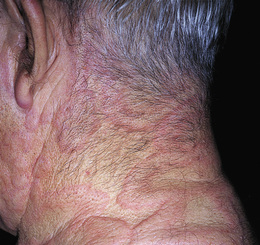Karen S. Abate Anaphylaxis is an acute life-threatening systemic event associated with exposure to an allergen. Manifestations of a hypersensitive anaphylactic reaction occur across multiple organ systems, including the cardiovascular, respiratory, integumentary, gastrointestinal, and central nervous systems. Reactions may occur within seconds to days after exposure to the offending allergen.1,2 It is imperative that an anaphylactic reaction be immediately recognized and treated appropriately to prevent an untoward outcome. It is estimated that in the United States the prevalence of anaphylaxis is 1.6% or greater.3 Common offending allergens include food, medication, insect venom, latex, occupational or inhaled allergens, radiocontrast media, cold air, exercise, heat, blood products, and potentially any substance (Box 25-1).1–3 An anaphylactic reaction occurs when there is a rapid release of immunoglobulin E in an immune hypersensitivity reaction, resulting in the activation of mast cells and basophils.4,5 On activation, histamine, platelet-activating factor, prostaglandins, leukotriene, and heparin are released.4–6 The clinical presentation is reflective of the systemic effects of these inflammatory mediators. The release of histamine stimulates vasodilation, increases vascular permeability, increases heart rate and force of contraction, and increases glandular secretions.5 The release of prostaglandins results in bronchoconstriction, coronary vasoconstriction, and peripheral vasodilation.5 Leukotriene release further stimulates bronchoconstriction and increases vascular permeability.5 The result can be a potentially life-threatening upper or lower airway obstruction causing bronchospasm, hypoxemia, or respiratory distress. All of these, as well as vascular collapse and angioedema (Fig. 25-1), are indicative of a severe reaction. Anaphylactic reactions differ in how long they take to manifest. Uniphasic and biphasic reactions can occur anywhere from minutes to up to 10 hours after exposure.1,2 Protracted reactions can be severe, lasting from 24 to 32 hours.1,2 The intensity of previous hypersensitivity reactions is not an indication of intensity of subsequent occurrences.1 In addition, clinical presentation may vary in severity from pruritic dermal rashes to more severe systemic manifestations. A comprehensive history and physical examination are invaluable. This information should be obtained from the patient as well as the family and those who have witnessed an anaphylactic event whenever possible.2 The clinician must determine the following: • Significant past medical history • Detailed past and current exposure history • Onset and severity of presenting symptoms • Medications or herbal supplements used • Alternative or home remedies implemented
Anaphylaxis
Definition and Epidemiology
Pathophysiology
Physical Examination and Clinical Presentation

Full access? Get Clinical Tree


Anaphylaxis
Chapter 25



